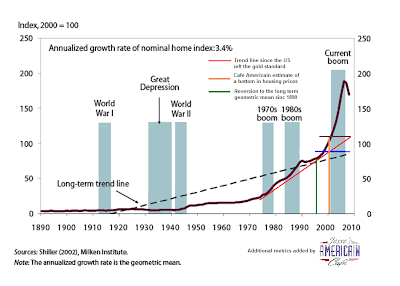 The easy times, the extended bull market in equities and corporate profits, with a disinflation and an easy money policy, created a lot of very wealthy people who managed other people's money by riding the incoming tide of the Greenspan era and a willingness to use the world's reserve currency to run up incredible levels of debt.
The easy times, the extended bull market in equities and corporate profits, with a disinflation and an easy money policy, created a lot of very wealthy people who managed other people's money by riding the incoming tide of the Greenspan era and a willingness to use the world's reserve currency to run up incredible levels of debt.
The disparity of wealth in the US from the wealthiest few to the less fortunate many has never been greater since the start of the Great Depression. And if history repeats there will be a tremendous effort to make the public pay for most of it.
Privatize the gains, but socialize the losses. Having the public bad bank buy the bad assets of the big money center banks and financial ponzi schemes and take all the losses is a thinly disguised act of theft and injustice on an almost incomprehensible scale.
There will be no lending until we drive the bad assets out of the insolvent banks. And the way to do this is to restructure the banks and write off their bad debts, and apportion the losses to the shareholders and credit holders, while backing the individual depositors and guaranteed pension funds one hundred percent.
We cannot continue to subsidize a few big money center banks from their losses, and call anything in our government a republican democracy of the people, by the people, and for the people.
"Nationalization" does not mean that the government will run the banks. Nationalization means that a body like the FDIC will take an insolvent bank, liquidate its assets, arrange for the payment of creditors, and either sell the assets to other banks, or allow a solvent bank to emerge from the process. This is what the FDIC does with any bank that fails, that is not a a powerful manipulator of the political process.
A 'bad bank' or a guarantee of private banking assets by the government is the subsidy of private losses by public money. It is a continuance of a fraud.
We either have a free market, with both gain or loss, or we have a managed economy where the Federal Reserve Bankers and ex-bankers decide who succeeds and who fails, who gains and who loses, who commands and who serves.
No matter who pays for it, the party is over.
Bloomberg
Insurers’ Corporate-Bond Losses May Exceed Subprime
By Andrew Frye
Feb. 3 (Bloomberg) -- Corporate debt defaults may cost U.S. life insurers “substantially” more than losses on securities linked to subprime, Alt-A and commercial mortgages, said Eric Berg, an analyst at Barclays Plc.
Corporate defaults are poised for a “significant” increase this year as the recession deepens, Berg, based in New York, said in a research note yesterday. The American Council of Life Insurers estimated the industry, led by MetLife Inc. and Prudential Financial Inc., holds $1 trillion in corporate debt.
 “None of the life insurers we studied appear to be doing a particularly good job” of picking bonds backed by companies, Berg said. “Understandably, investors are concerned.”
“None of the life insurers we studied appear to be doing a particularly good job” of picking bonds backed by companies, Berg said. “Understandably, investors are concerned.”
Life insurers have plummeted in the last year in New York trading as investment losses and guarantees on slumping retirement products sap capital. Hartford Financial Services Group Inc. leads the industry with $7.9 billion in writedowns and unrealized losses tied to the real estate market since 2007, while New York-based MetLife has accumulated $7.2 billion, according to Bloomberg data.
Hartford and Prudential have cut jobs, asked regulators to ease reserve standards and applied for aid from the government’s $700 billion rescue program to replenish funds after reporting net losses in the third quarter. MetLife sold $2.3 billion of stock in October to bolster finances. The Standard & Poor’s Supercomposite Life & Health Insurance Index has declined about 60 percent in the last 12 months...




































